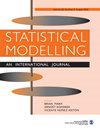Recurrent Events Analysis with Piece-wise exponential Additive Mixed Models
IF 1.2
4区 数学
Q2 STATISTICS & PROBABILITY
引用次数: 4
Abstract
Background: Recurrent events analysis plays an important role in many applications, including the study of chronic diseases or recurrence of infections. Historically, most models for the analysis of time-to-event data, including recurrent events, have been based on Cox proportional hazards regression. Recently, however, the Piece-wise exponential Additive Mixed Model (PAMM) has gained popularity as a flexible framework for survival analysis. While many papers and tutorials have been presented in the literature on the application of Cox based models, few papers have provided detailed instructions for the application of PAMMs and to our knowledge, none exist for recurrent events analysis. Methods: The PAMM is introduced as a framework for recurrent events analysis. We describe the application of the model to unstratified and stratified shared frailty models for recurrent events. We illustrate how penalized splines can be used to estimate non-linear and time-varying covariate effects without a priori assumptions about their functional shape. The model is motivated for both, analysis on the gap timescale ("clock-reset") and calendar timescale ("clock-forward"). The data augmentation necessary for the application to recurrent events is described and explained in detail. Results: Simulations confirmed that the model provides unbiased estimates of covariate effects and the frailty variance, as well as equivalence to the Cox model when proportional hazards are assumed. Applications to recurrence of staphylococcus aureus and malaria in children illustrates the estimation of seasonality, bivariate non-linear effects, multiple timescales and relaxation of the proportional hazards assumption via time-varying effects. The R package pammtools has been extended to facilitate estimation, visualization and interpretation of PAMMs for recurrent events analysis. Conclusion: PAMMs provide a flexible framework for the analysis of time-to-event and recurrent events data. The estimation of PAMMs is based on Generalized Additive Mixed Models and thus extends the researcher’s toolbox for recurrent events analysis.基于分段指数加性混合模型的递归事件分析
背景:复发事件分析在许多应用中发挥着重要作用,包括慢性疾病或感染复发的研究。从历史上看,大多数用于分析事件时间数据的模型,包括周期性事件,都是基于Cox比例风险回归。然而,最近,分段指数加性混合模型(PAMM)作为一种灵活的生存分析框架得到了广泛的应用。虽然文献中有许多关于Cox模型应用的论文和教程,但很少有论文为pamm的应用提供详细的说明,据我们所知,没有针对循环事件分析的论文。方法:引入PAMM作为反复事件分析的框架。我们描述了该模型在重复事件的非分层和分层共享脆弱性模型中的应用。我们说明如何惩罚样条可以用来估计非线性和时变协变量效应,而不需要对其功能形状的先验假设。该模型的动机是对间隙时间刻度(“时钟重置”)和日历时间刻度(“时钟前进”)进行分析。详细描述和解释了应用于循环事件所需的数据扩充。结果:模拟证实,该模型提供了协变量效应和脆弱方差的无偏估计,并且在假设成比例风险时与Cox模型等效。金黄色葡萄球菌和疟疾在儿童中复发的应用说明了季节性的估计、二元非线性效应、多重时间尺度以及通过时变效应放宽比例危害假设。R包pamtools已被扩展,以方便用于循环事件分析的pamm的估计、可视化和解释。结论:PAMMs为事件发生时间和复发事件数据的分析提供了一个灵活的框架。pamm的估计是基于广义加性混合模型,从而扩展了研究人员的工具箱用于循环事件分析。
本文章由计算机程序翻译,如有差异,请以英文原文为准。
求助全文
约1分钟内获得全文
求助全文
来源期刊

Statistical Modelling
数学-统计学与概率论
CiteScore
2.20
自引率
0.00%
发文量
16
审稿时长
>12 weeks
期刊介绍:
The primary aim of the journal is to publish original and high-quality articles that recognize statistical modelling as the general framework for the application of statistical ideas. Submissions must reflect important developments, extensions, and applications in statistical modelling. The journal also encourages submissions that describe scientifically interesting, complex or novel statistical modelling aspects from a wide diversity of disciplines, and submissions that embrace the diversity of applied statistical modelling.
 求助内容:
求助内容: 应助结果提醒方式:
应助结果提醒方式:


